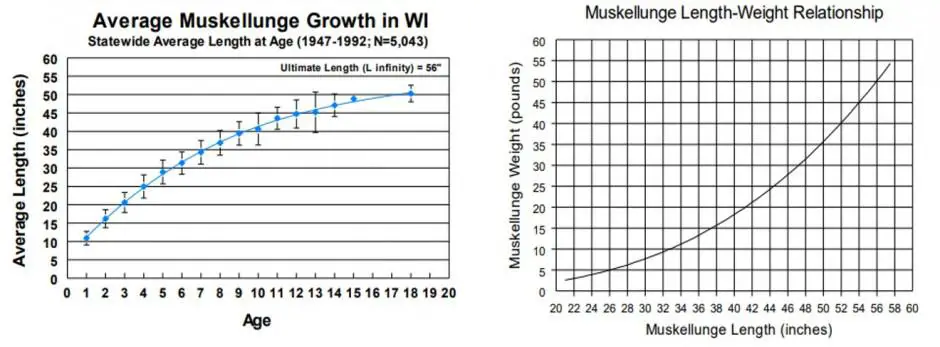The musky is the biggest member of the Esox family and has a reputation as one of the most fun, and infuriating, northern freshwater fish out there. Musky are known for being fierce fighters, growing to huge sizes,
The world record for the biggest musky is 72 inches in length and 67 lbs 8 oz by weight. While those are the extremes for how big a musky can get, sizes of 38 inches and 16 lbs are pretty common sizes for adult musky with many trophy sized musky reaching much larger sizes.

https://www.kpcw.org/post/dwr-wants-grow-trophy-sized-muskie-jordanelle-reservoir#stream/0
I’ve talked about how fast northern pike grow here at Northern Pike Fishing Tips, and now that you know everything you could want to know about that, it’s time to tackle the even larger cousin: the Muskellunge!
Just How Big Do Musky Get?
Among freshwater fish, especially to the far north, the Muskie rules the waters. These amazing fish can grow to huge sizes, and are notoriously hard to catch. The nickname “fish of 10,000 casts” is very well earned.
There’s also the fact that big musky are huge. The average adult musky is often twice the size of the average northern pike, and there’s a whopping 12 lb difference between the IGAF world record for musky vs. pike.
Those are some big fish!
Even though they are known for reaching trophy size, just how big is that for a musky? How common is it for them to reach that size?
Musky Size Tables
Keep in mind that these tables are estimates based on ranges. No table is going to be 100% perfect and local environment matters a lot, especially when looking at age vs. size.
Musky in the south tend to grow much faster than average, but also die much younger. Musky in the north can live many years more than average but at the northernmost range of their environment they grow slower to get to those sizes.
Table 1: Average Musky Weight by Length
| Length (In) | Avg Weight | Thin Build | Thick Build |
|---|---|---|---|
| 35 | 11.8 lbs | 9.8 lbs | 14 lbs |
| 38 | 13.9 lbs | 10.7 lbs | 17 lbs |
| 40 | 15.2 lbs | 12.1 lbs | 20.2 lbs |
| 42 | 21.2 lbs | 16.2 lbs | 25.2 lbs |
| 45 | 23.8 lbs | 20.0 lbs | 29 lbs |
| 48 | 31.5 lbs | 23.2 lbs | 35.4 lbs |
| 50 | 34.5 lbs | 25.6 lbs | 42 lbs |
| 52 | 37.0 lbs | 29.8 lbs | 46.5 lbs |
| 55 | 43.3 lbs | 35.5 lbs | 51 lbs |
| 58 | 49.2 lbs | 43 lbs | 61 lbs |
| 60 | 57.0 lbs. | 51.2 lbs | 64.4 lbs |
| 62 | 60+ lbs. | 54.8 lbs | World Record Territory |
A couple of notes on the above table:
Musky can look very, very different. The avg. weight for a length is just that, the overall average. Thin build refers to musky that have a long head and tend to be longer in body with less of a gut.
Thick build refers to the other common appearance of a musky with a blunt head and thick body (the type of fish where you say “Whoa, he’s a big eater!”).
If you have one of these two common body builds as opposed to a “average” musky, that can help you get a more accurate weight range for what you are probably looking at.
These are rough estimates because conditions vary from lake to lake and so many factors can radically shift the actual weight of a musky – especially at those bigger sizes.
As an example, take a look at this musky weight estimation guide from a large lake in northern Minnesota:
Table 2: Average Musky Size Northern Minnesota Lakes
| Length (In) | 30 | 34 | 36 | 40 | 42 | 46 | 50 | 54 | 58 |
| Weight (Lbs) | 7.2 | 10.6 | 12.2 | 17 | 20 | 25.9 | 33.2 | 41.6 | 51.7 |
That table is from northern Minnesota and while some averages are very comparable to the musky size tables above it, you’ll also notice some major differences.
That’s even without dealing with the average body vs. thin body vs. thick body musky weight comparisons.
Another example is this table from In-Fisherman that gives a mathematical formula, but you might notice something off about it. If you notice the end weights are larger than any musky ever caught, yup that’s exactly the problems that can arrive with weight charts!
Finally, there are these great charts from multiple years of studies and records of the State of Wisconsin DNR:
Those charts from the state of Wisconsin show the size of muskies by age in the state as well as size by length vs age and weight vs length.
That’s a lot of data – but it goes to show you what the size of the average musky is going to be in some of the best muskellunge fishing waters in the world.
Assuming you’re willing to put in your 10,000 casts 🙂
Talk to Local Guides about Big Muskies
Local guides or long time musky anglers in the area will generally have a pretty good idea of how the age/length/weight relationship with muskies in the area works.
You always need to take local knowledge worth a grain of salt, especially from fellow fishermen you ask for a story, but they also provide some of the best local insight for how the lake you’re fishing compares to these muskellunge size averages.
There might be a local lake where musky tend to be extra long but more on the thin side. Or the opposite, where the average musky is a little shorter in length but they have giant guts and tip the scales on the heavy side.
Locals can show you the way as far as these go.
3 Giant Musky Caught Video!
In Conclusion
There’s no way about it: musky can get huge. There’s a reason they are such a popular fresh water fish with anglers. Awesome fighters, tricky to catch, and making for awesome photos, these are great fish.
Musky even taste great if you’re in a state where that’s allowed (most areas are catch and release with limited exceptions). That’s it. You now have all the resources you need to see just how big muskies get!

